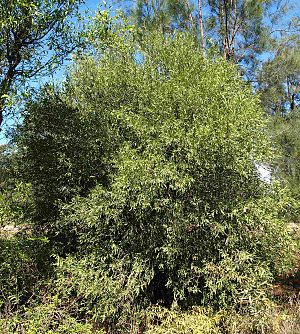Boonaree facts for kids
The boonaree (also called inland rosewood) is a small tree or large bush found in Australia. It belongs to the Sapindaceae family, which also includes plants like soapberries. This tough plant grows in the dry inland parts of Australia.
Quick facts for kids Boonaree |
|
|---|---|
 |
|
| Scientific classification | |
| Genus: |
Alectryon
|
| Species: |
oleifolius
|
| Synonyms | |
|
Heterodendrum oleifolium Desf. |
|
Contents
About the Boonaree
How Scientists Name Plants
Scientists give plants special names to help everyone know exactly which plant they are talking about. This is called taxonomy. In 1818, a French botanist named René Louiche Desfontaines first described the boonaree. He gave it the name Heterodendrum oleifolium.
Later, in 1987, scientists decided it fit better in a different group of plants called Alectryon. So, its scientific name became Alectryon oleifolius. The "oleifolius" part of its name means "olive-leaved," because its leaves look a bit like those of an olive tree.
Other Names for Boonaree
This plant has many common names, depending on where you are in Australia. Some people call it western rosewood, bullock bush, cattle bush, jiggo, boonery, boneree, bush minga, applebush, or red heart.
Different Types of Boonaree
There are three main types, or subspecies, of boonaree.
- One type, elongatus, is taller and has longer, greener leaves. It grows in eastern New South Wales on heavier soils.
- Another type, canescens, has greyer leaves. It grows on sandy soils with limestone and can often grow new plants from its roots.
- The third type, oleifolius, is found in the northern parts of Western Australia.
What the Boonaree Looks Like
The boonaree can grow as a large bush or a medium-sized tree. It can reach up to 9 meters (about 30 feet) tall. Its branches often hang down. The trunk has grey to brown bark with deep grooves. Its leaves are stiff, long, and narrow. They are a greyish-green color and can be 3.5 to 14 centimeters long.
Where the Boonaree Grows
You can find the boonaree across all the dry inland parts of Australia. In New South Wales, it grows in the drier areas of the state's interior and west. It often grows on sandy soils that have limestone, usually alongside another tree called belah (Casuarina cristata).
Boonaree in Nature
Leaf Shedding
The boonaree sheds its leaves, especially during the warmer summer months.
Boonaree and Animals
Even though animals like cattle used to eat boonaree leaves, especially when other food was scarce, it's not always good for them. The plant contains natural chemicals. If animals, especially those with multiple stomachs like cows, eat too much of it, these chemicals can make them sick. This is more likely to happen if the animals are very hungry or if they eat the new, fresh growth. At other times, animals have eaten the leaves without any problems.
How Boonaree Spreads
Some groups of boonaree plants can grow new plants from their roots. This means they form small patches of plants that are all genetically the same, like clones.
Images for kids


